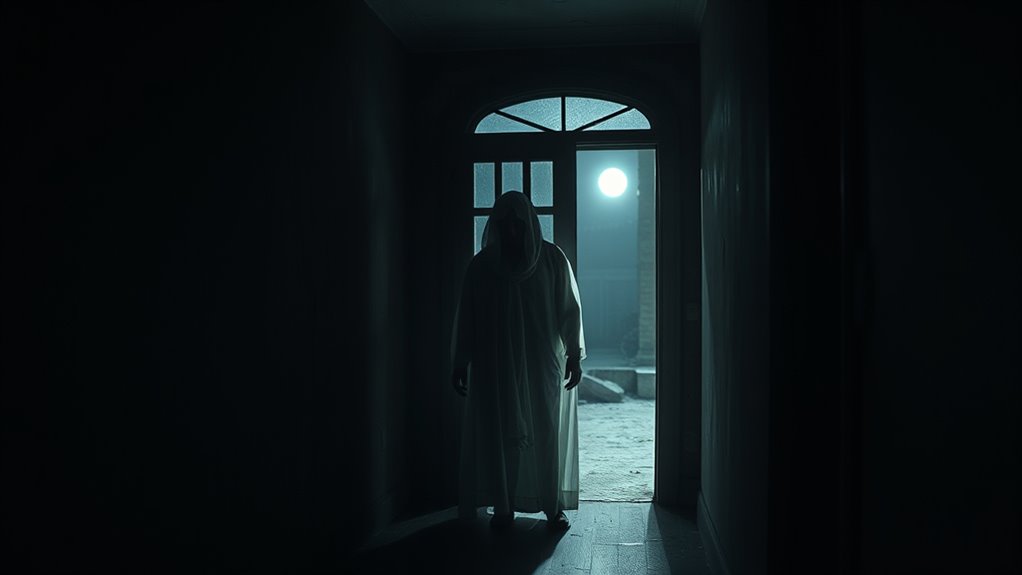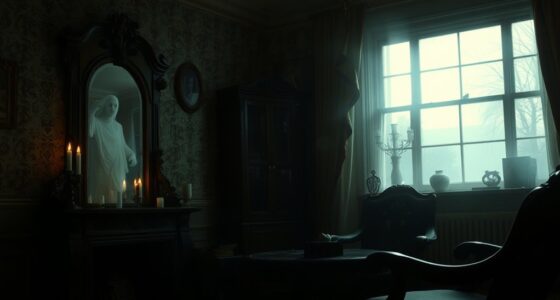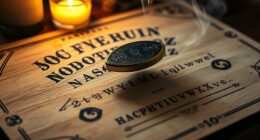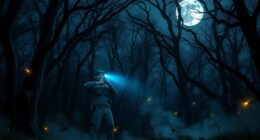If ghosts are real, you might expect clear proof, but scientific evidence remains absent because investigations often face environmental interference, psychological biases, and equipment limitations. Many claimed sightings or sounds have natural explanations or are misinterpreted, making it hard to verify any ghostly presence. Without repeatable, objective data, the scientific community stays skeptical. If you’re curious, understanding why no conclusive proof exists can shed more light on this mysterious topic.
Key Takeaways
- Scientific standards require reproducible, verifiable evidence, which ghost phenomena have yet to provide.
- Many supposed sightings and recordings are explained by natural causes, environmental factors, or psychological biases.
- Equipment used in paranormal investigations is prone to false positives and interference, complicating proof.
- Personal stories and anecdotal evidence lack the empirical validation needed for scientific acceptance.
- The elusive nature of ghosts and limitations of current technology make definitive proof unlikely at this time.

Have ghosts truly left evidence of their existence, or is it all just illusions and stories? That question has haunted many for generations. When you think about paranormal investigations, you’re often faced with mysterious photos, eerie sounds, and unexplainable sensations. Yet, despite numerous claims, concrete proof remains elusive. Skeptics argue that most supposed evidence can be explained away by natural causes, psychological factors, or outright hoaxes. Scientific skepticism reminds us to approach such phenomena with caution, demanding rigorous proof before accepting anything as fact. As a result, many paranormal experts and investigators work tirelessly to find hard evidence, but their findings often fall short of scientific standards. Online platforms facilitate the exposure of marital betrayals and sometimes include allegations of infidelity, which can be as elusive as ghostly proof. You might have seen compelling videos or heard chilling recordings, but without verifiable data, these pieces of evidence are often dismissed as fakes or misinterpretations. Paranormal investigations rely heavily on equipment like EMF meters, infrared cameras, and audio recorders. Still, skeptics point out that these devices are prone to false positives, and their readings can be influenced by environmental conditions or electrical interference. Environmental factors, such as electromagnetic interference, can easily produce misleading readings, further complicating the quest for proof. Additionally, psychological effects like suggestion and expectation can influence how people interpret ambiguous stimuli, making it even harder to distinguish genuine phenomena from hallucinations or biases. Moreover, scientific standards for proof have yet to be satisfied in this field, which fuels ongoing skepticism. For every supposed ghostly anomaly captured, there’s usually a logical explanation waiting to be uncovered. This ongoing debate fuels the tension between believers and skeptics, keeping the question of proof unresolved. Furthermore, peer-reviewed research in this area is scarce, which hinders the development of a scientific consensus. It’s tempting to believe in ghosts when you hear personal stories from those who claim to have experienced encounters. But anecdotal evidence, while emotionally compelling, doesn’t carry the weight needed for scientific validation. Many scientists remain unconvinced because they require repeatability and objective verification—standards that ghost sightings rarely meet. Despite decades of paranormal investigations, no one has produced conclusive, universally accepted evidence that proves spirits or ghosts exist beyond doubt. This absence of irrefutable proof keeps the subject firmly in the domain of speculation, folklore, and personal belief.
Frequently Asked Questions
Can Personal Experiences Alone Prove Ghosts Exist?
You might think personal experiences alone prove ghosts exist, but they rely heavily on subjective perceptions and personal anecdotes. While these stories can be compelling, they lack scientific validation and can be influenced by biases or misinterpretations. To truly prove ghosts exist, we need objective, repeatable evidence. Until then, personal anecdotes remain intriguing but aren’t enough to establish definitive proof of the supernatural.
Why Do Some Ghost Sightings Lack Physical Evidence?
You might wonder why many ghost sightings lack physical evidence. Paranormal skepticism suggests that personal experiences can be influenced by perception, making evidence skepticism common among skeptics. You may notice that eyewitness accounts are subjective, and physical proof is often imperceptible or easily dismissed. This lack of concrete evidence fuels doubt, even when you believe in the possibility of ghosts, showing why definitive proof remains elusive despite numerous sightings.
Are There Scientific Explanations for Ghost Phenomena?
Pondering paranormal research, you realize scientific explanations often dominate skeptic viewpoints, suggesting ghost phenomena might be psychological or environmental rather than supernatural. While some believe in spirits, many scientists see sensations as subconscious states, sound waves, or sensory illusions. Despite persistent paranormal pursuits, concrete proof remains elusive, prompting you to contemplate that what we interpret as ghosts could be misunderstood mind tricks or natural phenomena, rather than paranormal phenomena.
How Do Cultural Beliefs Influence Ghost Sightings?
Cultural beliefs greatly influence your ghost sightings, as superstitious rituals and folklore traditions shape how you interpret mysterious experiences. If you grow up in a culture that emphasizes spirits and hauntings, you’re more likely to see signs or feel presence in ambiguous situations. These cultural frameworks can create expectations, making you more prone to interpret unexplained events as supernatural. Your environment and learned beliefs therefore considerably impact your perception of ghostly phenomena.
What Technological Methods Are Used to Detect Ghosts?
Think of ghost detection as trying to catch whispers in the wind; elusive and faint. You use paranormal sensors like EMF meters, infrared cameras, and audio recorders to catch these unseen whispers. These tools aim to pick up energy fluctuations or anomalies that might hint at spirits. While advanced, they often struggle with false positives, making proof hard to pin down. Still, they’re your best shot at revealing the unseen.
Conclusion
So, if ghosts are real, why isn’t there proof? Maybe it’s because they hide in shadows, whisper in silence, and drift beyond sight. Maybe they slip through cracks in our understanding, dance just out of reach, or fade into the unknown. Until they choose to reveal themselves, you’ll only wonder, only seek, only imagine. The mystery remains alive, whispering softly, waiting patiently — a ghostly dance forever out of your grasp.









